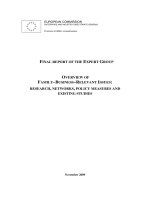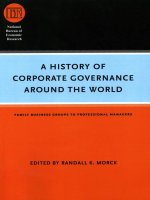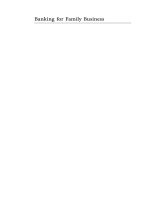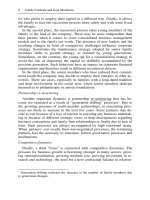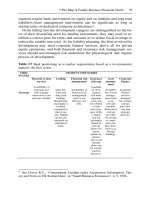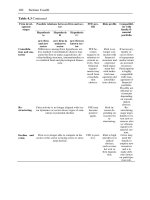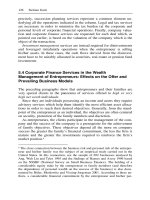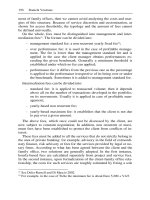Building family business champions
Bạn đang xem bản rút gọn của tài liệu. Xem và tải ngay bản đầy đủ của tài liệu tại đây (11.17 MB, 272 trang )
Building Family Business Champions
Building
Family Business
Champions
Eric G. Flamholtz and Yvonne Randle
STANFORD BUSINESS BOOKS
An Imprint of Stanford University Press
Stanford, California
Stanford University Press
Stanford, California
© 2016 by the Board of Trustees of the Leland Stanford Junior University.
All rights reserved.
No part of this book may be reproduced or transmitted in any form or by any
means, electronic or mechanical, including photocopying and recording, or in any
information storage or retrieval system without the prior written permission of
Stanford University Press.
Special discounts for bulk quantities of Stanford Business Books are available to
corporations, professional associations, and other organizations. For details and
discount information, contact the special sales department of Stanford University
Press. Tel: (650) 736-1782, Fax: (650) 736-1784
Printed in the United States of America on acid-free, archival-quality paper
Library of Congress Cataloging-in-Publication Data
Flamholtz, Eric, author.
Building family business champions / Eric G. Flamholtz and Yvonne Randle.
pages cm
Includes bibliographical references and index.
isbn 978-0-8047-8419-1 (cloth : alk. paper) — isbn 978-0-8047-9802-0 (electronic)
1. Family-owned business enterprises—Management. 2. Success in business.
I. Randle, Yvonne, author. II. Title.
hd62.25.f58 2016
658.4—dc23
2015028101
Typeset at Stanford University Press in 10.5/15 Minion
To the family behind Bell-Carter Foods,
in particular Tim Carter; his brother, Jud Carter;
and Tim’s son, Tim T. Carter
Contents
Preface
ix
Acknowledgments
xv
PART I BUILDING FAMILY BUSINESS CHAMPIONS
1 A Framework for Building Family Business Champions
2 The Evolution of Family Businesses
3
29
PART II TOOLS FOR BUILDING FAMILY BUSINESS CHAMPIONS
3 Strategic Planning
4 Organizational Structure and Roles
61
85
5 Performance Management
103
6 Culture Management
125
PART III SPECIAL ISSUES IN FAMILY BUSINESSES
7 The Dark Side
147
8Leadership
171
9Succession
193
10 Lessons Learned
217
Appendix: Family Business Self-Assessment Tools
231
Notes
237
Index
245
Preface
We wrote this book to help businesses understand what to do to become
a “family business champion”—that is, a family business that has undergone at least two successful leadership transitions from one generation to
the next, while simultaneously growing and remaining profitable. Research
has shown that only one-third of family businesses are passed successfully
to a second generation of family leadership.1 In addition, “only 13 percent
of successful family businesses last through the third generation.”2 Maintaining family business success for more than one generation is clearly a
difficult task. Nevertheless, many companies have achieved this, including
Simon Property Group (a NYSE-listed shopping mall developer and operator), Westfield (an Australian and U.S. shopping mall developer and operator), GOJO™ (developer and manufacturer of Purell™), and Heineken (the
Dutch beer brewer).
The number of family businesses that have been highly successful for
more than one generation and can therefore be called family business champions is quite small, and there are even fewer family businesses that have been
successful for four or more generations. Any family business that has been successful for four generations can be called a “family business dynasty.” Companies that have achieved this special status include Bechtel, SC Johnson &
Son, and Bank Santander in Spain.3 Throughout this book, we describe the
evolution of another company that has achieved this elite status—Bell-Carter
Foods. We use Bell-Carter (which has had four generations of successful
x
Preface
family leaders over a 100-year period) as a unifying case to illustrate the concepts, frameworks, and methods we advocate for building family business
champions.
A Look at One Family Business Champion: Heineken
Heineken, a true family business champion, has prospered over four generations of family leadership and more than 150 years.4 Heineken was founded
when Gerard Adriaan Heineken, then 22 years of age, bought a brewery
in the heart of Amsterdam in 1864.5 The young Heineken had no experience in brewing, but brewing was to become his passion and his life’s work.
He had vision, treated customers and employees well, and strived for
consistently high quality in his product. His vision was to expand the brewery to become the largest and best in Europe.6 He was also committed to
experimentation and continuous improvement, not only in product quality
but also in methods of brewing alternative types of beers. On January 11,
1873, he officially incorporated “Heineken Bierbrouwerji Maatschappij NV”
also known as “HBM.” It should be noted that this resulted in the transition
of Heineken from a pure family business to a quasi-family business.
Four Generations
Gerard died unexpectedly in 1893, at the age of 51. Although Gerard’s widow
was the majority shareholder, she was not prepared to run the company
herself, so she appointed a family friend, J. D. A. Peterson, as a director
of HBM. One year later she married Peterson, who became stepfather to
Henry Pierre Heineken, Gerard’s son.7 In effect, Peterson became caretaker
of the business until Gerard’s son, Henry Pierre, could assume leadership.
On October 1, 1914, Henry Pierre Heineken became a director of HBM,
and three years later he was appointed chairman. Henry Pierre Heineken,
who held a doctorate in chemistry, managed the company from 1917 to 1940
and continued his involvement with the company until 1951. Under his
leadership, HBM developed techniques to maintain consistent beer quality
in large-scale production. During their tenure at HBM, Peterson worked
alongside two other directors, and Heineken worked with three others in
what has been described as a “very close-knit team.”8
Preface
Henry Pierre’s son, Alfred Henry Heineken, who was born in 1923, began
working at the company in 1941 at the age of 18. Freddy, as he preferred to
be called, was not originally interested in the business except as an owner
and left the running of the business to the company’s directors.9 Freddy
preferred artistic pursuits and at first seemed to be a classic third-generation scion under whose “leadership” the business would likely decline.
After World War II, when the company began to focus more on exports
and becoming a global brand, the brewery management “asked Leo Van
Munching, Heineken’s U.S. importer, to teach ‘little Freddy’ the finer points
of the business.”10
To the surprise of management, Freddy emerged as a successful salesman and with a new-found interest in the family business. During the prior
generation’s leadership, the family’s share of stock ownership had been
diluted. Freddy’s mission was to return majority ownership to the family.
When he succeeded in doing so by 1954, Freddy described it as “the masterpiece of my working life.”11
One of Freddy’s strengths was his ability to think strategically, and
this was a key ingredient in Heineken’s continued global expansion. As he
stated: “I am a generational thinker and I think in terms of 25 to 50 years
ahead. It is an entirely different way of thinking than, for example, the way
a director thinks in maximum periods of 5 years.” He used a chess metaphor
to describe his business dealings, stating: “It is fun to checkmate people.”12
Freddy retired from the executive board in 1989 but maintained involvement with the company until his death in 2002.
Freddy’s daughter, Charlene de Carvalho-Heineken, born on June 30,
1954, is the fourth generation of the Heineken family to be involved in the
business. At this writing, she owns a controlling interest in the world’s thirdlargest brewer, Heineken International, and sits on the company’s board of
management. Her mark on the company is a work in progress. Her husband
is also a member of the board.
Today, Heineken is a family business dynasty and one of the leading
brewing groups in the world. Although we are not privy to the internal
Heineken family dynamics, the firm’s success suggests a healthy functional
family, generation after generation.
xi
xii
Preface
Becoming a Family Business Champion
Since its founding in 1978, our firm has worked with hundreds of companies,
approximately 45 percent of them family businesses—including some of the
family business champions mentioned here (Simon Property Group, GOJO™,
Westfield, Techmer PM, and Bell-Carter Foods). Drawing on this experience
and on our research, this book provides a framework for understanding what
must be done to become a family business champion. We provide a set of concepts and managerial tools to help achieve this challenging objective including planning, performance management, and culture management. We also
provide a unique set of questionnaires to facilitate the self-assessment of the
extent to which a specific family business is positioned for long-term success.
Throughout the book, we examine both successful and unsuccessful
family businesses and analyze the lessons that can be derived from each one.
All of the unsuccessful companies are disguised unless they are in the public
domain.
•
•
•
The book is organized in four parts. Part I consists of two framework chapters. Chapter 1 defines family business and family business champions and
presents a “formula” for family business success that is based on managing
what we call “family functionality” and the development of the company’s
“infrastructure.” Chapter 2 provides a framework for understanding and
identifying the stages of family business development.
Part II describes the managerial tools needed to manage and develop a
family business successfully—strategic planning (chapter 3), organizational
structure (chapter 4), performance management (chapter 5), and culture
management (chapter 6). We examine each topic from a dual perspective:
the technical aspects of the tools and the family business issues involved in
their application.
Part III deals with the unique issues facing family businesses. Chapter 7
focuses on the “dark side” or dysfunctional aspects of family businesses.
Chapter 8 deals with effective leadership. Chapter 9 presents a process for
managing leadership succession.
In chapter 10 we step back from our discussion of individual companies
and tools and offer insights and conclusions about what is required to become a family business champion.
Preface
The appendix contains a self-scored questionnaire that a family business can use to evaluate the extent to which it has developed the four essential managerial tools—strategic planning, structure, performance management, and culture management.
•
•
•
This book makes several significant contributions to the family business
literature. First, our overall approach is unique because we focus on what
must be done holistically to create a successful family business. Specifically,
we deal with the issues of family business from the perspective of the family
and the business. We provide a framework or template for building family
businesses capable of lasting multiple generations. The framework also is
helpful in understanding and analyzing family business issues in relation to
business issues more broadly.
Second, we make several important conceptual contributions to thinking about family business with constructs such as “family business functionality and dysfunctionality,” the “family business foundation,” “family
business equilibrium,” and the “family business success formula.” We offer
some new analytical frameworks, including six factors that must be managed to achieve a high degree of family functionality and a set of dysfunctional family business syndromes (see chapter 7).
Third, we provide assessment tools that can be used to improve family
businesses. In chapter 1, we present two self-scored questionnaires for assessing the two key aspects of the family business success formula: (1) organizational development and (2) family functionality. Using the results of these
questionnaires, the family business can identify which “type” it is (chapter 2). Chapter 2 also describes the “conditional stages” of family business
development (which are based, in part, on the family business type) that will
help leaders understand how to increase their company’s effectiveness at the
current stage and prepare for the next. The appendix provides methods for
assessing the effectiveness of key family business management tools.
Our Unique Perspective
We believe that we offer a virtually unique perspective on family business
for several reasons. First, as noted earlier, a large percentage of the companies that our firm, Management Systems (based in Los Angeles, but with
xiii
xiv
Preface
global affiliates), has worked with since its founding in 1978 have been family businesses. Second, we are ourselves a family business, albeit first generation. As a husband-and-wife team (with the occasional involvement of
other family members), we understand the unique challenges of making a
family business work. Third, we have had the rare opportunity to be consultants to one family business, Bell-Carter Foods, for more than twenty years,
since 1993.13 The confidence of the Carter family in bringing us back several
times during that period presented an opportunity to conduct longitudinal
research in our role as both participant and observer. We are not aware of
any other published in-depth study of a family business’ development and
transfer of leadership from one generation to the next over such an extended period. Our involvement was similar to research by anthropologists
who visit tribes or communities over time.
Acknowledgments
While we present a number of case examples throughout this book, four of
our clients allowed us to share their stories in more depth. We owe them a
special thank you. We thank Jim Goodwin, CEO of Taylor-Dunn, for sharing his company’s values and the story of how they were developed. John
Manuck, founder and CEO, and his son, Ryan Howley, president, of Techmer PM, are an example of successful family business succession; we thank
John, Ryan, and David Turner, managing director of Techmer’s Fiber Division, for their time in helping us prepare this case study. Joe Kanfer, CEO,
and his daughter, Marcella Kanfer Rolnick, vice chair, of GOJO™ Industries, shared their family business story with us over the course of several
interviews. They also provided extensive input on the case study of GOJO™
and on the description of Marcella’s transition to her leadership role. We
are grateful to both for their time and for allowing us to present their story.
A very special thank you goes to the Carter family, whose family business,
Bell-Carter Foods, Inc., serves as a case study throughout this book. Both
Tim Carter, retired CEO, and his son, Tim T. Carter, spent hours with us
telling their family’s story.
We have always enjoyed the self-deprecating humor of the Carter f amily.
When asked if they would be willing to serve as a case study for two books
we were considering writing—one dealing with successful organizations and
the other with troubled or failing companies—Tim replied, “Sure. Which
book will we be in?” When we asked Tim T. (now CEO) for permission to
Acknowledgments
include his company as a case study, he said, “Yes, and I hope we will still be
in business when it is published!”
One of our favorite stories about Tim and Jud occurred in our early
years of working with the company. En route to dinner one evening after a
management development session, Jud, who was driving the car everyone
referred to as the “Love Boat,” stopped for gas and a quick car wash. As the
four of us began to go through the car wash, Tim said to Jud, “I hope you’ve
closed your window.” At that very second, water began streaming through
the window adjacent to Jud’s seat, drenching both of the Carter brothers.
Tim, in his best straight-man voice, turned to us in the back seat and said
simply, “See what I have to deal with?”
Without the Carters’ permission to use Bell-Carter as our unifying case,
the richness of this book would have been greatly diminished. They are the
apotheosis of a functional family and a true family business champion. While
not a perfect company—and they would be the first to say so—they are our
role model for a successful family business, and a worthy model for any business. We are virtually certain that, after reading this, one of them will ask us,
“Who were you talking about in that book?”
Another heartfelt thank you goes to Margo Beth Fleming, our editor at
Stanford University Press. This is our second book with Margo, and we have
worked well together because she is a consummate professional. When we
proposed this book, we knew she had been looking for a book dealing with
family business for a number of years, but had not found exactly the right
concept. Margo not only trusted us to write the book, but also made important contributions to its development. When Margo went on maternity
leave, Geoffrey Burn not only fully embraced the project, but also contributed to it. He was a great partner for the final leg of the book’s three-year
journey to publication. We were blessed to have these two wonderful editors as our partners in this writing project.
Building Family Business Champions
Part I
Building Family Business
Champions
1
A Framework for
Building Family Business
Champions
Arthur Bell, born in 1888, and his older brother Henry were sons of a California doctor. Both brothers left home to work in a cotton factory at a time
when doing so was an opportunity to make a good living. After a few years
of this work, Arthur and Henry moved back to California and purchased
an olive grove. The year was 1912, and this was the beginning of what would
become Bell-Carter Foods—a family business that has grown and thrived
for more than 100 years.
Like Bell-Carter, some families succeed in building family businesses
that are “sustainably successful” over many generations. Cargill, Mars,
Bechtel, Bank Santander, Heineken, Samsung Electronics, and TATA Steel
are among the largest and most successful businesses in the world. These
are true family business champions. Other families, at some point, sell all
or a part of the business to nonfamily members—sometimes remaining active in the business (on the board, in specific management positions, etc.)
and sometimes exiting the business entirely. Ford Motor Company, Simon
Property Group, Samsung Electronics, Bank Santander, and 99 Cents Only
Stores, for example, made the transition from family-held to publicly held,
with family members remaining active in the business. Other family businesses last no more than one generation. Like a rock band with one hit
song, these companies are a “one-generation wonder.”
What are the secrets of those family businesses that grow and thrive
over multiple generations to become family business champions? Is there a
formula for long-term success? What can be learned from businesses that
experience difficulties and last only one generation or decide to sell and exit
Building Family Business Champions
(sometimes because family members cannot work effectively together)? Do
they point to pitfalls that can be avoided?
This chapter provides a framework for understanding the challenges of
building family businesses that last for generations. As we shall see, family businesses face all of the challenges and problems that other businesses
do, but they also have problems and challenges that are unique to their
“species.” Here we provide criteria for assessing the extent to which a family
business has the systems, processes, structure, and family dynamics needed
to ensure its long-term success. We build on this framework throughout the
book and explain how it can be used to promote successful family business
development and create family business champions.
What Is a Family Business?
The typical perception or stereotype is of a small and unsophisticated company. Small family businesses are sometimes referred to as “mom and pop.”
However, as we shall see below, this stereotypical archetype is rarely accurate.
It should be noted that no “generally accepted” definition of a family
business exists in the literature. For the purposes of this book, we define a
family business as any business in which there is an owner, entrepreneur, or
founder that employs one or more family members.1 These other members
might be spouses, children, siblings, cousins, parents, in-laws, and others.
An organization can begin life as a family business or can evolve into one.
Bell-Carter and Simon Property Group are examples of companies that
began as family businesses—with brothers (two at Bell-Carter and three
at Simon) as the founders. In Bell-Carter’s case, the company was a family
business from the very beginning, jointly owned by brothers Henry and
Arthur Bell. Simon Property Group was founded by Mel Simon, who later
invited his younger brothers Herb and Fred to join the firm.
The unique challenge facing a family business can be summed up simply: dealing effectively with family in a business context.2 This challenge
raises a dizzying array of issues, including:
•
The role of family members in the business
•
The effect of interpersonal conflict among family members as it
plays out in day-to-day business activities
A Framework
•
The perception by other employees of favoritism, nepotism, or
incompetence of family members
•
Discomfort of nonfamily employees in working with, confiding in,
criticizing, managing, or challenging the performance or ideas of
family members
•
Separating family financial needs from business needs
•
Financial compensation of family members
•
Management and leadership succession among family members
•
Differences in motivation and ability across generations
•
The complexity of managing a family business as family members
come of age across generations
•
The perception of “the family” as an entity in the minds of non
family member employees
This list is not exhaustive. Nevertheless, it suggests the added layers of
complexity that must be dealt with in managing and growing a family
business effectively. Running a family business may not be more complicated than running a giant like General Electric, Microsoft, or Nestlé.
However, family-related challenges may explain why so few family businesses achieve the status of giant while continuing to operate as familyowned enterprises.3 Research indicates that a family that perpetuates its
business from generation to generation is rare. One study finds that only 13
percent of family businesses last through the third generation.4
The Family Business “Success Formula”
Our focus in this book is how a family business can become a “family business
champion”—that is, a family business that operates successfully over multiple
(at least two) generations. The question of how to become a “sustainably successful” family business is best answered through a combination of research
and the analysis of the actual experience of family businesses. That is the approach we take in this book. Having worked with family businesses since 1978,
we have developed our own formula for achieving family business success.
Perhaps not surprisingly, most of the literature on family business success
has focused on family characteristics and dynamics (both within and outside
Building Family Business Champions
the business), and sometimes on the characteristics of the business as it exists
apart from the family. One study found that family enterprises that treat the
family and the business as a holistic unit have better family results (and similar business results) than enterprises that pay attention only to the business
in running their companies.5
Our approach to understanding family business success is based on a
different perspective. Rather than focus only on the characteristics and attributes of a family business per se, we believe that there are two dimensions
of family business success that need to be explicitly recognized and managed: (1) organizational or business development and (2) family functionality. Our approach is supported by our own experience and research on
organizational effectiveness, and to some extent by the research of Mark
Leenders and Eric Waarts.6
The first dimension, organizational development, is defined as the
systems, processes, and structure that support effective and efficient operations. The second dimension, family functionality, is defined as the way
family members relate to and work with one another within the business—
categorized as either “functional” or “dysfunctional.” A functional family
is one whose dynamics are “healthy” in a social or psychological sense. A
dysfunctional family is one whose dynamics are “unhealthy” in a social or
psychological sense.
The relationship between these two dimensions (or “family business success factors”) and long-term family business success is shown in Figure 1.1
A Framework for Successful
Organizational Development
Based on our work and research with organizations of all sizes and types—
including family-owned businesses—we have developed a framework for
building the “infrastructure” (systems, processes, structure) needed to pro-
Degree of
organizational
development
+
Degree of
family
functionality
Figure 1.1. “Formula” for Family Business Success
=
Degree of
family
business success

